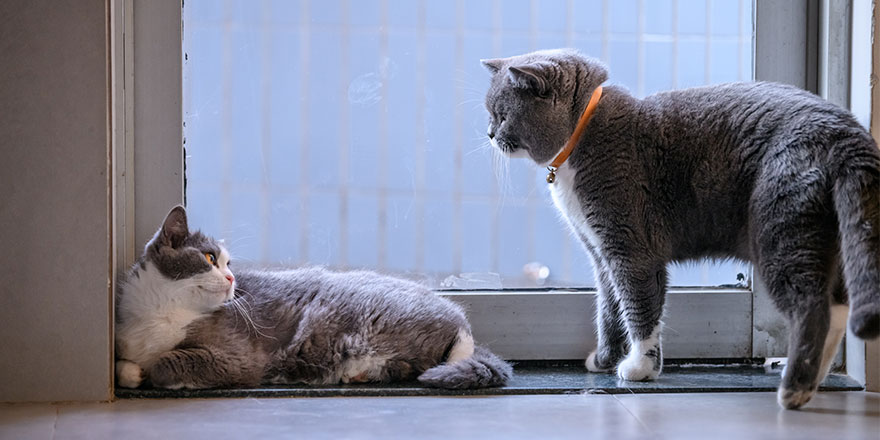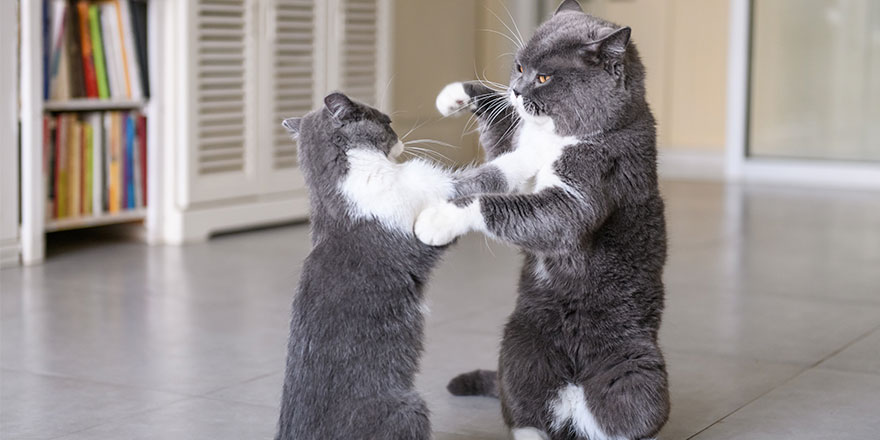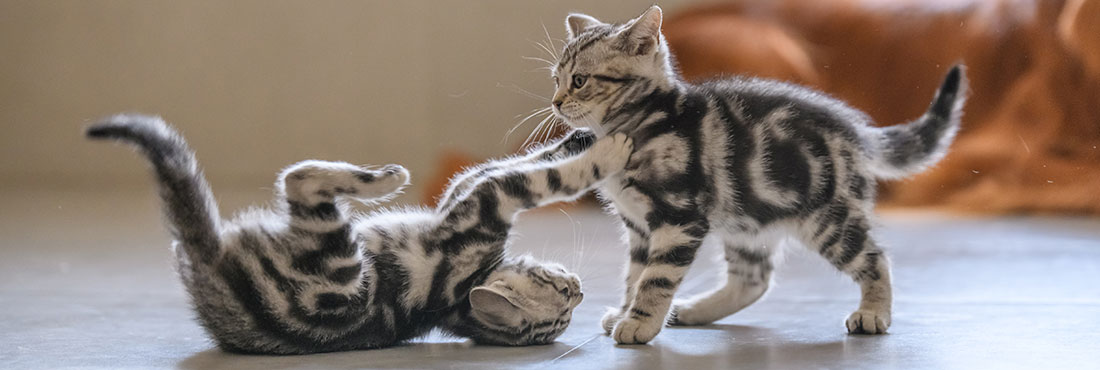Cat behavior is both fascinating and difficult to interpret. At no time is this more obvious than when cats are playing or fighting with another cat. But which is it? If you have more than one cat living in your home, this could be something that happens on a regular basis. Cat owners see it in adult cats as well as in kittens. We have compiled all the best expert opinions on how to tell what is going on with this cat’s behavior. So, if you are asking are my cats playing or fighting, you have come to the right place!
How Cats Socialize with Other Cats
Kittens from the same litter mock fight all the time using play bites and scratches on their sisters and brothers. It is a way for them to experiment with how hard you need to bite to get a reaction. They also learn about stalking, pouncing, and chasing by using play aggression.
As they get older, cats tend to be solitary animals but they can also live together in the same social group. You will often see felines in households where there are two cats or even in multi-cat households grooming each other. They may even sleep next to the other cat. Play fighting can be a part of this relationship.
Cats that are settled into a household together are said to be ‘affiliated’ and they are less likely to have a real fight. However, they could still fall out if they have to compete for resources.

What Cats Playing Should Look Like
So, you are most likely to see play fighting between two cats from the same litter when they are still young or between cats that are used to living together. If you see two cats playing or fighting and they already know and get on with each other – it is more likely to be playing. If it is between two cats that have never met before, it is more likely to be fighting. Cats will take a long time to get to know each other before they get friendly enough to have a play fight!
Playing at fighting is most common in kittens at around 8-10 weeks of age so any interaction at this age is almost certainly playing.
These play sessions usually take place in an environment that has plenty of stimulation such as boxes, a cat tree, and other obstacles. It often involves the entry and exit holes of such toys and involves a lot of chasing and leaping around!
Top Signs That Cats Are Only Playing
By carefully observing your cat’s body language, you can soon tell if this is a play session or a fight. Here are the main things to look out for:
- No single cat is dominant. During playtime, cats take turns chasing and being rough. If one cat is doing all the chasing and is always on top of the other, it is not playing.
- Ears in normal position. Cats playing fighting will have their ears upright or slightly forward.
- Bodies positioned forward. During play, cats lean forward towards the other cat.
- Minimal biting. Any biting that does take place is gentle and brief.
- Claws retracted. When cats are playing, they keep their claws inside their paws because they do not want to harm their playmate.
- Flat fur. If your cat is playing, one of the main signs is that their fur will remain flat on their body.
Top Signs That Cats are Fighting for Real
Sometimes, you may spot two cats interacting in a way that suggests they are not getting on well. If you are wondering are my cats playing or fighting, these are the main signs of a true catfight:
- Cat hissing and growling. If you hear any hissing and growling these are both aggressive sounds and it is a sign of confrontation. It indicates that the cats are fighting.
- Ready for biting. The cats will have their mouths open with their teeth bared and ready to bite into the flesh of their opponent.
- Ears turned back. This is a sign of aggression in cats – the ears could even be flat on their head.
- Hair on body and tail sticking up. When the fur on a cat’s tail and body is sticking up straight, it is called piloerection. It is an aggressive sign and your pet is trying to make themselves look bigger.
- Aggressive posture. In cats, an aggressive posture is positioning the body turned to the side. Cats fighting do not normally face each other.
- Tail and whiskers position. Two key components of aggressive body language are the position of the tail and whiskers. When you see cats fighting, their tail is straight up with the tip bent or it may be swishing menacingly from side to side. The whiskers will be angled forward and will be spread apart.
You may also like our article on How to Stop a Cat Fight and Why They Happen

Reasons Why Cats Get Into Fights
If you can understand why cats get into fights, it will help you to stop them from breaking out in the first place. Here are some of the main reasons why cats fight according to cat behavior experts.
New cat in the home
This is the single most common reason that cats fight. They can be quite territorial and do not like another cat being introduced into what they view as their home. Often it is the older cat that has the issue and the more cats there are in the house, the worse the problem can be. You can overcome this by making the introduction gradual, using plenty of treats and possibly separating the cats with a baby gate.
Poor social skills
There is a critical point in a kitten’s development when they learn how to get on with other cats – it is called socialization. For most cats, this is between 2 and 9 weeks. Hand-raised kittens miss out on this and can develop into nervous and aggressive cats that get into fights. Speak to your vet or to a cat behavior expert for advice on how to help your kitty if this applies to them.
Competition for resources
Cats will fight if they both want the same thing. Although domestic cats usually have plenty of food and shelter, they can compete for human attention. Try to make sure that you have fun with all your cats in an equal way.
Outside territory
Many of us have woken to the sound of tomcats howling and spitting at each other outside our bedroom windows. These disputes are usually about territory and who it belongs to and are most common amongst unneutered males. Cats can get badly injured in these fights.
Maternal instinct
Breeding females can be particularly aggressive. A mother cat will fight ferociously to protect her kittens. If your cat is breeding, it may be best to keep other felines away from her for a while.
Ill health
If cats that have previously got on very well suddenly start fighting, it is worth investigating if one of them has become ill. There are several medical conditions that can make a cat more aggressive and these include epilepsy, rabies, dental disease, and hyperthyroidism. It could also be due to the sensory and cognitive decline in an older cat.
It is worth getting your cat’s teeth and general health checked out by your vet.
Genetics
Some cats are simply born grumpy! Recent research has shown that there are cat genes (one is connected to a biological system called the oxytocin receptor) that make cats more irritable. In the future, it may be possible to test a cat for the presence of these genes.
Sources:
- Aggression in Cats, ASPCA
- Minori Arahori, Yusuke Horia, Atsuko Saito, Hitomi Chijiiwa, Saho Takagi, Yuki Ito, Arii Watanabe, Miho Inoue-Murayama, KazuoFujita, The oxytocin receptor gene (OXTR) polymorphism in cats (Felis catus) is associated with “Roughness” assessed by owners, ScienceDirect
FAQs:
Yes, lots of cats love to play. They find it fun and most cats enjoy interacting with other felines. However, some cats prefer a solitary life and do not like company at all. A kitten will enjoy a lot of play fighting, for them playtime is a learning experience.
If you are satisfied that your cats are playing and neither cat is getting hurt then certainly you should let them get on with it. They will stop when they have had enough. However, if you notice that one cat looks as if they need a break, it is time to step in.
Yes, it is very normal behavior for a kitten and for a young cat and for cats that know each other very well. However, it would not be normal for play fighting to take place between a senior cat and a new cat that you have introduced to your home. It will take a while for the younger cat and your senior to bond sufficiently to have a play fight. This may never happen at all.
You need to be very careful about how you break up a cat fight because you could get hurt. Start by making a loud noise to distract the cats attention. You could yell, slam a door, stamp your feet or bang some pots together. Another option is to create a barrier between the cats using a piece of card or a cushion.
Do not try to break up the cats by putting your bare hands between them. The cats could scratch and bite your hands and may even lunge at your face. The cats can re direct their aggression towards you and this can result in a nasty injury. If you do get bitten by a cat, you need medical attention because cat bites often result in serious infections.
Once you have separated fighting cats, you need to prevent it from happening again. For a few days, keep the cats in separate rooms. You will need two sets of toys and food two litter boxes. Once things have calmed down, you can start to carefully reintroduce the cats to each other. You will need to supervise this at all stages.







